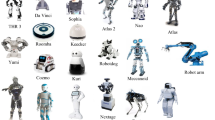Abstract
This article presents a study using social robots in a hotel public space. The objective of this study is to investigate people’s response to robot’s different speech. We used humanoid robot NAO for setting up our experiments: (i) A single robot greeted each guest. (ii) A single robot engaged in soliloquy about hotel’s information. (iii) Dual robots had conversations between each other about hotel’s information. In each experiment, hotel guests’ behavior in response to robot’s speech was studied by using four patterns that reflected the level of a guest’s interest to the robot’s speech. With these behavior-patterns, we analyzed the guests’ first and second responses after they encountered with the robot in the hotel. Our study helps to understand the practical effectiveness of robot’s speech in a public space context, which could inspire the design of hotel-assistive robots.










Similar content being viewed by others
References
Hayashi K, Sakamoto D, Kanda T, Shiomi M, Koizumi S, Ishiguro H, Ogasawara T, Hagita N (2007) Humanoid robots as a passive-social medium: a field experiment at a train station. In: Proceedings of the 2nd ACM/IEEE international conference on human–robot interaction (HRI ’07), pp 137–144
Kanda T, Shiomi M, Miyashita Z, Ishiguro H, Hagita N (2009) An affective guide robot in a shopping mall. In: Proceedings of the 4th ACM/IEEE international conference on human robot interaction (HRI ’09), pp 173–180
Tanaka F, Cicourel A, Movellan JR (2007) Socialization between toddlers and robots at an early childhood education center. Proc Natl Acad Sci USA 104(46):17954–17958
Thrun S, Bennewitz M, Burgard W, Cremers A, Dellaert F, Fox D, Hahnel D, Rosenberg C, Roy N, Schulte J, Schulz D (1999) Minerva: a second-generation museum tour-guide robot. In: Proceedings of 1999 IEEE international conference on robotics and automation, vol 3, pp 1999–2005
Sabelli AM, Kanda T, Hagita N (2011) A conversational robot in an elderly care center: an ethnographic study. In: Proceedings of the 6th ACM/IEEE international conference on human–robot interaction (HRI ’11), pp 37–44
Tapus A, Mataric MJ, Scassellati B (2007) Socially assistive robotics. IEEE Robot Autom Mag 14(1):35–42
Asoh H, Hayamizu S, Hara I, Motomura Y, Akaho S, Matsui T (1997) Socially embedded learning of office conversant robot Jijo-2. In: Proceedings of the international joint conference on artificial intelligence (IJCAI), pp 880–887
Bischoff R, Graefe V (2003) Hermes: an intelligent humanoid robot designed and tested for dependability. In: Proceedings of the international symposium on experimental robotics (ISER), pp 64–74
Roy N, Pineau J, Thrun S (2000) Spoken dialogue management using probabilistic reasoning. In: Proceedings of the 38th annual meeting on association for computational linguistics, pp 93–100
Pan Y, Okada H, Uchiyama T, Suzuki K (2013) Listening to vs overhearing robots in a hotel public space. In: Proceedings of the 8th ACM/IEEE international conference on human–robot interaction (HRI ’13), pp 205–206
Duranti A (1997) Universal and culture-specific properties of greetings. J Linguist Anthropol 7(1):63–97
Lee M-K, Makatchev M (2009) How do people talk with a robot?: an analysis of human-robot dialogues in the real world. In: Proceedings of CHI ’09 extended abstracts on human factors in computing systems, pp 3769–3774
Platon E, Sabouret N, Honiden S (2006) Overhearing and direct interactions: point of view of an active environment. In: Weyns D, Van Dyke Parunak H, Michel F (eds) Environments for multi-agent systems II. Springer, Heidelberg, pp 121–138
Schegloff EA (1967) The first five seconds: the order of conversational opening. Doctoral Dissertation, Department of Sociology, University of California
Pitsch K, Kuzuoka H, Suzuki Y, Sussenbach L, Luff P, Heath C (2009) The first five seconds: contingent stepwise entry into an interaction as a means to secure sustained engagement in HRI. In: Proceedings of the 18th IEEE international symposium on robot and human interactive communication (Ro-Man ’09), pp 985–991
Aarts H, Dijksterhuis A (2000) Habits as knowledge structures: automaticity in goal-directed behavior. J Pers Soc Psychol 78(1):53–63
Openni: Open-source sdk for 3d sensors. http://www.openni.org/
Neospeech: Text-to-speech software. http://www.neospeech.com/
Eyssel F, Kuchenbrandt D, Bobinger S, de Ruiter L, Hegel F (2012) If you sound like me, you must be more human: on the interplay of robot and user features on human-robot acceptance and anthropomorphism. In: Proceedings of the 7th ACM/IEEE international conference on human–robot interaction (HRI ’12), pp 125–126
Kendon A (1990) Conducting interactions: patterns of behavior in focused encounters. Cambridge University Press, Cambridge
Heenan B, Greenberg S, Manesh SA, Sharlin E (2014) Designing social greetings in human robot interaction. In: Proceedings of the 2014 conference on designing interactive systems (DIS ’14), pp 855–864
Acknowledgments
This study is conducted in cooperation with Remm Akihabara, Hankyu-Hanshin Daiichi Hotel Group, Japan.
Author information
Authors and Affiliations
Corresponding author
Rights and permissions
About this article
Cite this article
Pan, Y., Okada, H., Uchiyama, T. et al. On the Reaction to Robot’s Speech in a Hotel Public Space. Int J of Soc Robotics 7, 911–920 (2015). https://doi.org/10.1007/s12369-015-0320-0
Accepted:
Published:
Issue Date:
DOI: https://doi.org/10.1007/s12369-015-0320-0



